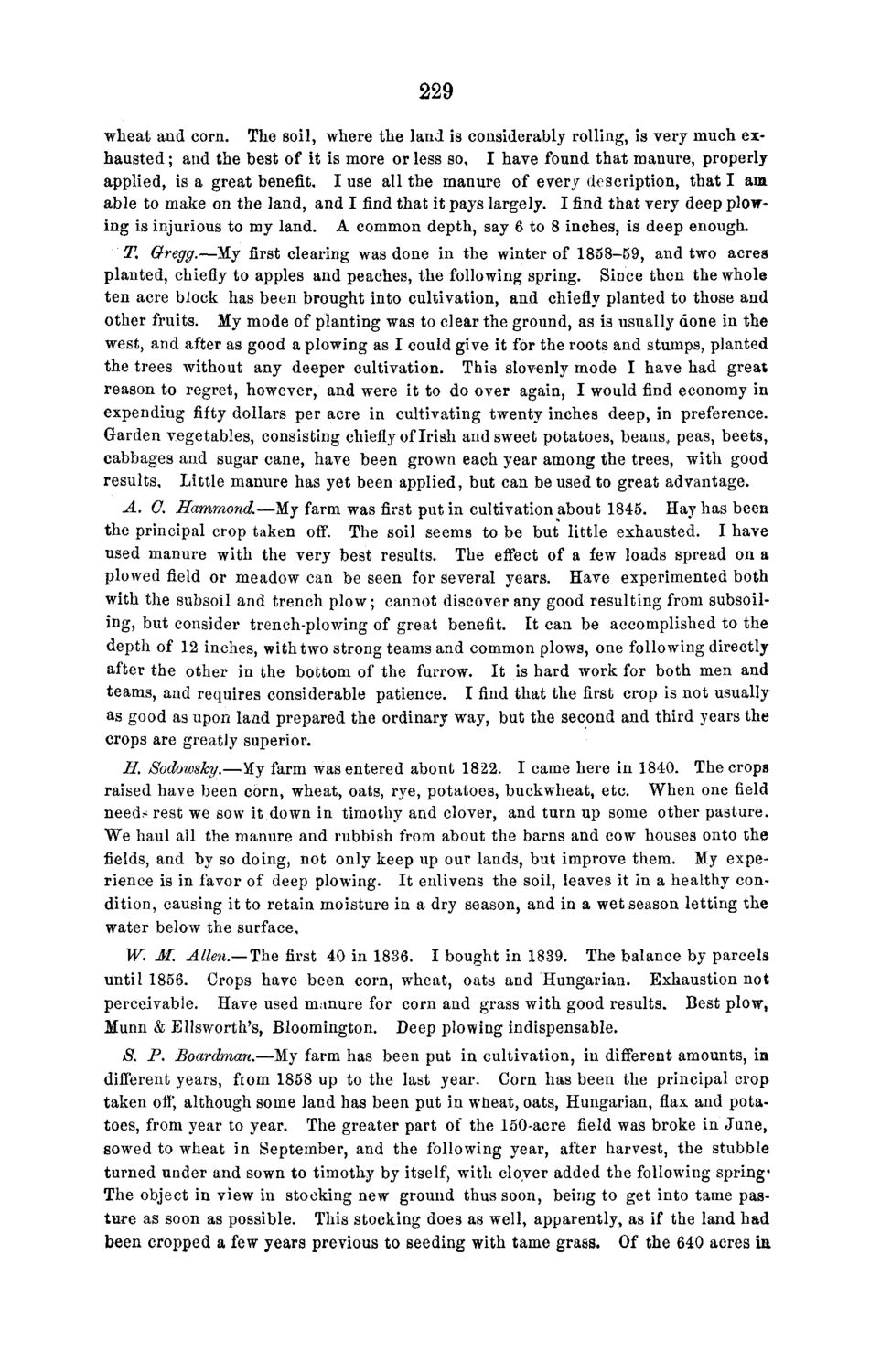| |
| |
Caption: Board of Trustees Minutes - 1868
This is a reduced-resolution page image for fast online browsing.

EXTRACTED TEXT FROM PAGE:
229 wheat and corn. The soil, where the land is considerably rolling, is very much exhausted ; aud the best of it is more or less so, I have found that manure, properly applied, is a great benefit, I use all the manure of every description, that I am able to make on the land, and I find that it pays largely. I find that very deep plowing is injurious to my land. A common depth, say 6 to 8 inches, is deep enough. T. Gregg.—My first clearing was done in the winter of 1858-59, and two acres planted, chiefly to apples and peaches, the following spring. Since then the whole ten acre block has been brought into cultivation, and chiefly planted to those and other fruits. My mode of planting was to clear the ground, as is usually done in the west, and after as good a plowing as I could give it for the roots and stumps, planted the trees without any deeper cultivation. This slovenly mode I have had great reason to regret, however, and were it to do over again, I would find economy in expending fifty dollars per acre in cultivating twenty inches deep, in preference. Garden vegetables, consisting chiefly of Irish and sweet potatoes, beans, peas, beets, cabbages and sugar cane, have been grown each year among the trees, with good results. Little manure has yet been applied, but can be used to great advantage. A. O. Hammond.—My farm was first put in cultivation about 1845. Hay has been the principal crop taken off. The soil seems to be but little exhausted. I have used manure with the very best results. The effect of a few loads spread on a plowed field or meadow can be seen for several years. Have experimented both with the subsoil and trench plow; cannot discover any good resulting from subsoiling, but consider trench-plowing of great benefit. It can be accomplished to the depth of 12 inches, with two strong teams and common plows, one following directly after the other in the bottom of the furrow. It is hard work for both men and teams, and requires considerable patience. I find that the first crop is not usually as good as upon land prepared the ordinary way, but the second and third years the crops are greatly superior. H. Sodowsky.—My farm was entered about 1822. I came here in 1840. The crops raised have been corn, wheat, oats, rye, potatoes, buckwheat, etc. When one field needs rest we sow it down in timothy and clover, and turn up some other pasture. We haul all the manure and rubbish from about the barns and cow houses onto the fields, and by so doing, not only keep up our lands, but improve them. My experience is in favor of deep plowing. It enlivens the soil, leaves it in a healthy condition, causing it to retain moisture in a dry season, and in a wet season letting the water below the surface, W. M. Allen.— The first 40 in 1836. I bought in 1839. The balance by parcels until 1856. Crops have been corn, wheat, oats and Hungarian. Exhaustion not perceivable. Have used manure for corn and grass with good results. Best plow, Munn & Ellsworth's, Bloomington. Deep plowing indispensable. S. P. Boardman.—My farm has been put in cultivation, in different amounts, in different years, from 1858 up to the last year. Corn has been the principal crop taken off, although some land has been put in wheat, oats, Hungarian, flax and potatoes, from year to year. The greater part of the 150-acre field was broke in June, sowed to wheat in September, and the following year, after harvest, the stubble turned under and sown to timothy by itself, with clover added the following spring* The object in view in stocking new ground thus soon, being to get into tame pasture as soon as possible. This stocking does as well, apparently, as if the land had been cropped a few years previous to seeding with tame grass. Of the 640 acres ia
| |